Vargas' Podcasts
Powered by 🌱Roam GardenLearning About Teachable
- Blog Post Complete
- Notes
- https://teachable.com/blog/teachable-course-examples
- https://reachable-agency.medium.com/a-brief-history-of-teachable-and-why-we-think-its-amazing-9d06ef95d2fa#:~:text=Teachable%20(which%20was%20previously%20named,access%20to%20students%20Udemy%20provided.
- Teachable (which was previously named Fedora!) was founded as a side project by Ankur Nagpal. As a course builder himself, he was utilising Udemy to bring his mobile marketing course to the masses but became increasingly frustrated by the lack of direct access to students Udemy provided.
- Open source engineers have direct access to users, but in some ways they don't. The only interface is GitHub's issues/discussions, which is a one way channel from user => creator. There's no direct creator => user.
- After a few days, he convinced his partner Conrad to use his e-learning platform on behalf of his agency, and so, Fedora had it’s first paying customer! After a while, Fedora on-boarded more and more customers and hired contractors to keep up with demand. But there was a problem, Fedora wasn’t built to host multiple courses and it simply didn’t have the technical capacity to keep up.
- By the start of 2016, their team grew to 15 people with the site hosting 5,000+ teachers, 12K+ courses and 700K students. Teachable is proud to have transparency as one of its core values and in 2017, they reported their primary revenue channel of Monthly Recurring Revenue had reached $550,000, not bad for a side project that was only ever meant to host one course!
- > “Transparency is one of the four core internal values at Teachable. Outside of compensation information, we believe in making every single aspect of our business transparent internally.” — Ankur Nagpal
- WHY ANKUR WHY
- So, where is Teachable is 2019? Teachable is now five years old and hosts 25,000 creators who teach 20+ million people!
- Goals for Floss
- Sooooo many examples of products and agencies built on the backs of other companies
- Teachable (which was previously named Fedora!) was founded as a side project by Ankur Nagpal. As a course builder himself, he was utilising Udemy to bring his mobile marketing course to the masses but became increasingly frustrated by the lack of direct access to students Udemy provided.
- https://artplusmarketing.com/how-we-acquired-26-447-users-and-207-152-in-sales-on-product-hunt-211940650fcb
- we launched on Product Hunt on April 15 2014
- The vision behind Fedora was simple — building the easiest way for people to make money teaching online courses without having to go to a marketplace and give up ownership.
- I literally could swap out "teaching online courses" with "developing open source software"
- Six months in, we had attracted a small base of beta users, who were collectively processing a few thousand dollars in monthly transactions across ten different monetizing schools.
- After stumbling on Product Hunt, it became clear that this would be a great place to “launch” — not just because of the traffic it would inevitably bring, but the fact that PH looked like the right channel to launch fast and ugly.
- So after getting an intro to Ryan, I was pretty stoked when this happened:
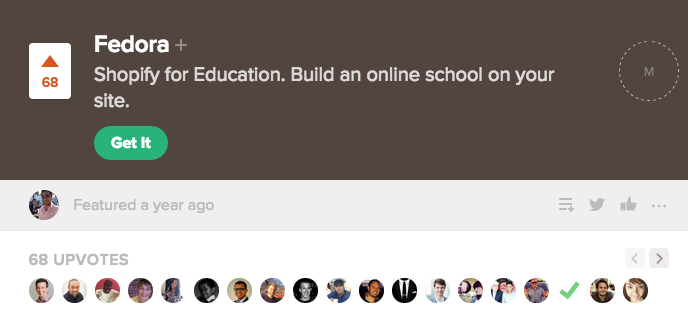
- 30 upvotes. 64 signups. 2 paying users.
- The 2 paying users was probably the coolest part though — not huge, but a massive victory at the time since I had only built the ability to pay for a Fedora account the day before ☺
- We went on to become one of the first “single-person-in-a-room” products that launched publicly on Product Hunt that eventually become a full-fledged company with $2m in funding, a full-time team of 9 and even an office.
- > Instead of being exposed to Product Hunt once on launch, every time one of our teachers had a launch, it got us in front of the PH community.
- Very interesting network effect. Every time your creators win, you win. See Twitch as another great example of this.
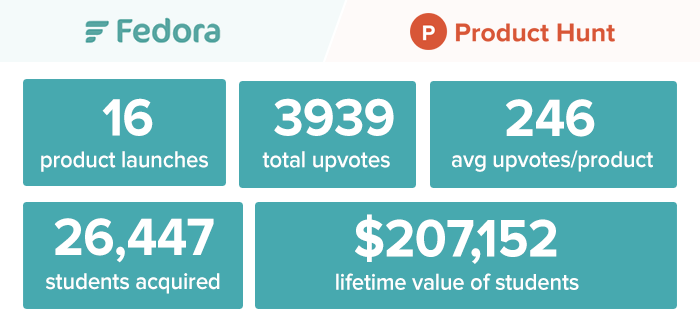
- Wow. Product Hunt had driven $207,152 in lifetime course sales and 26,447 students.
- Holy shit. Product Hunt is a great channel for acquiring both a high volume of users and most critically, users that are willing to pay for products. That’s huge since most other channels get you either quantity or quality.
- Our creators built high-quality products. The average number of upvotes each of those courses received (246) is substantially above the Product Hunt average (~81). Also, since our teachers tend to eventually create multiple courses, a user derived from PH might eventually have multiple product purchases driving their LTV up.
- Still an early adopter audience. Non-programming, marketing and design courses have not performed anywhere near as well on Product Hunt traffic in terms of number of upvotes, dollar value of sales, conversion rates or pretty much any other metric. Not to say this won’t change, but right now Product Hunt’s sweet spot is still programming, marketing and design — and by a long shot.
- Product Hunt is a real, tangible business. That is no mean feat for a community-driven product (Digg, anyone?).
- We should be paying Product Hunt
- Considering these results were produced serendipitously, we would be willing to pay a serious amount of money if we could strategically invest in Product Hunt as an acquisition channel.
- Off the top of my head, we’d love to collaborate with Product Hunt in at least three different ways:
- On-site Payments: PH could dramatically increase conversion by allowing their community to buy the course on their site and take a percentage. It’s a lot of work to become a payments company so it’s probably not immediately interesting but very high potential.
- Technology Licensing / Sub-hunts: Since we are a white-labeled platform for teachers, we do absolutely nothing for the people that come to us every day looking for the newest cool courses on our platform. If we could work with PH to set up some kind of “PH for Fedora Courses”, that’d be a unique way of handling course discovery . I’d also bet that it would increase the percentage of our teachers that complete creating the course they are working towards since they would have an audience to launch it to.
- Interesting
- Sponsored Products: This one is obvious and probably an intuitive next step — but the idea of a Sponsored Product. Looking at the numbers indicated above, I find it hard to imagine this wouldn’t be a positive-ROI ad spend for any high-quality online course in programming, marketing or design.
- Don't like this
- https://medium.com/swlh/how-a-side-project-grew-up-to-become-a-company-66df8634c787
- The pervasive Silicon Valley myth goes something like this: founder is passionate about solving a huge problem, raises millions driven by a powerful vision, and amidst much struggle finally changes the world.
- Our story isn’t like that.
- Fall 2013
- Fedora started as a side project to scratch an itch.
- I was teaching courses on Udemy with my partner Conrad. We were making some money, but it appeared unwise to market courses to students that we would have no direct access to.
- So I locked myself in a room for three days and built an incredibly rudimentary website to sell my mobile marketing course directly to people.
- A few days later, I convinced Conrad to use this tool on behalf of his agency and become our first paying customer. The week after, we signed our second and third paying customers as an unnamed side project.
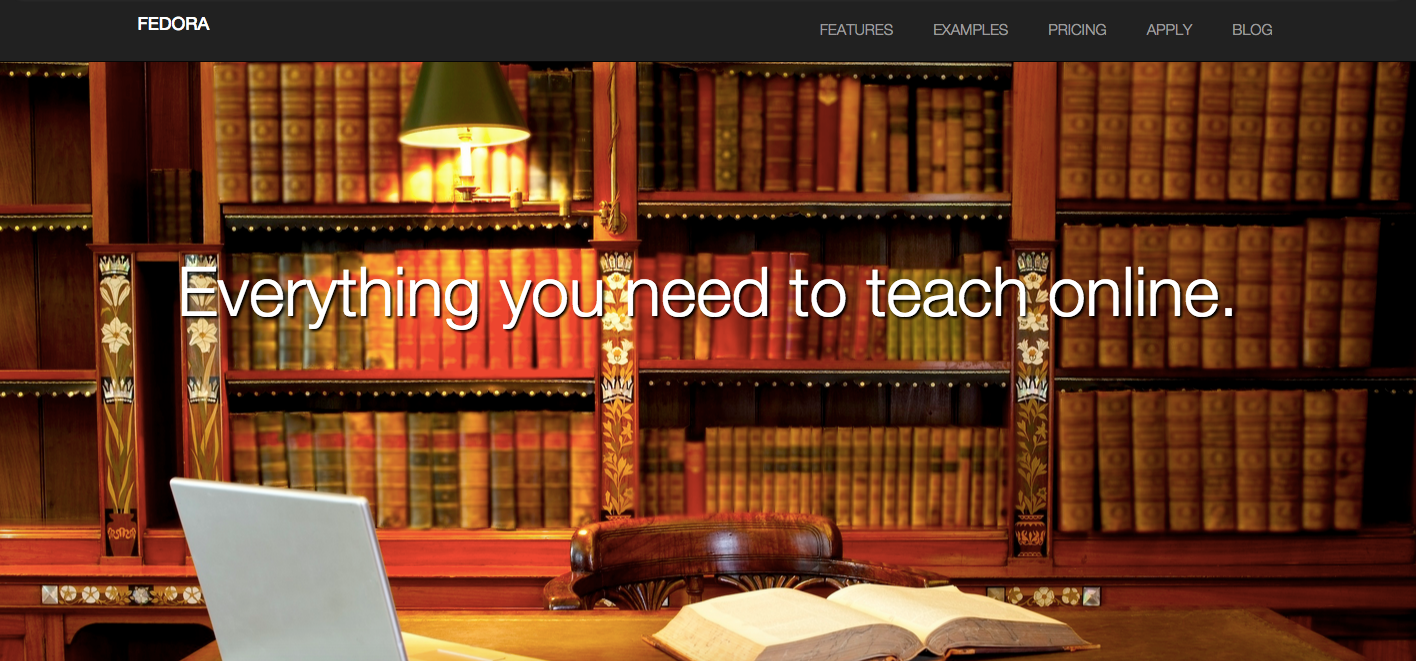
- Our stellar first landing page
- A side project that was never built to be a startup. There was no bigger vision and I snarked at the “change the world” rhetoric that permeates technology startups.
- This was a simple side project with a tiny bit of traction that needed a name. So, I picked a name out of a figurative hat and Fedora was born.
- Summer 2014
- We had tens of active customers that were not just using the product, but slowly shaping what the product was becoming.
- We hired our first contractor and our first employee. Three weeks later, he brought in our second. Another friend showed up and worked for free until he became an entirely indispensable part of the company.
- We hired our third employee. Then, my partner and first customer made the jump from advisor to become a full time co-founder.
- > Something amazing was happening.
- Contractors became employees. Customers became investors. An advisor became a co-founder. Somewhere along the way, we became a team.
- It wasn’t all rainbows and butterflies. My hastily hacked together technology sucked. Paying no heed to the second-system effect, we set out to rebuild the entire product from the ground up.
- The second-system effect proposes that, when an architect designs a second system, it is the most dangerous system they will ever design, because they will tend to incorporate all of the additions they originally did not add to the first system due to inherent time constraints. Thus, when embarking on a second system, an engineer should be mindful that they are susceptible to over-engineering it
- That would define who we were to become.
- Instead of building a team around an existing product, we got the rare opportunity to build a brand new product as a team.
- A product that belonged equally to all of us that we all put a little piece of us into — something that would always be ours no matter what we do in the future.
- Decided to rebuild from the ground up when it was more than just him
- Fall 2015
- It’s been two wild years. We have helped 5,000+ teachers launch 12K+ courses, teach 700K students and make over $3.5 million.
- Somewhere down the line, we also started to believe in certain things.
- Contrary to being founded on a specific vision, these convictions came slowly. They evolved organically as a result of daily interactions with our customers over multiple years.
- The “change the world” rhetoric that I scoffed at? Guilty as charged.
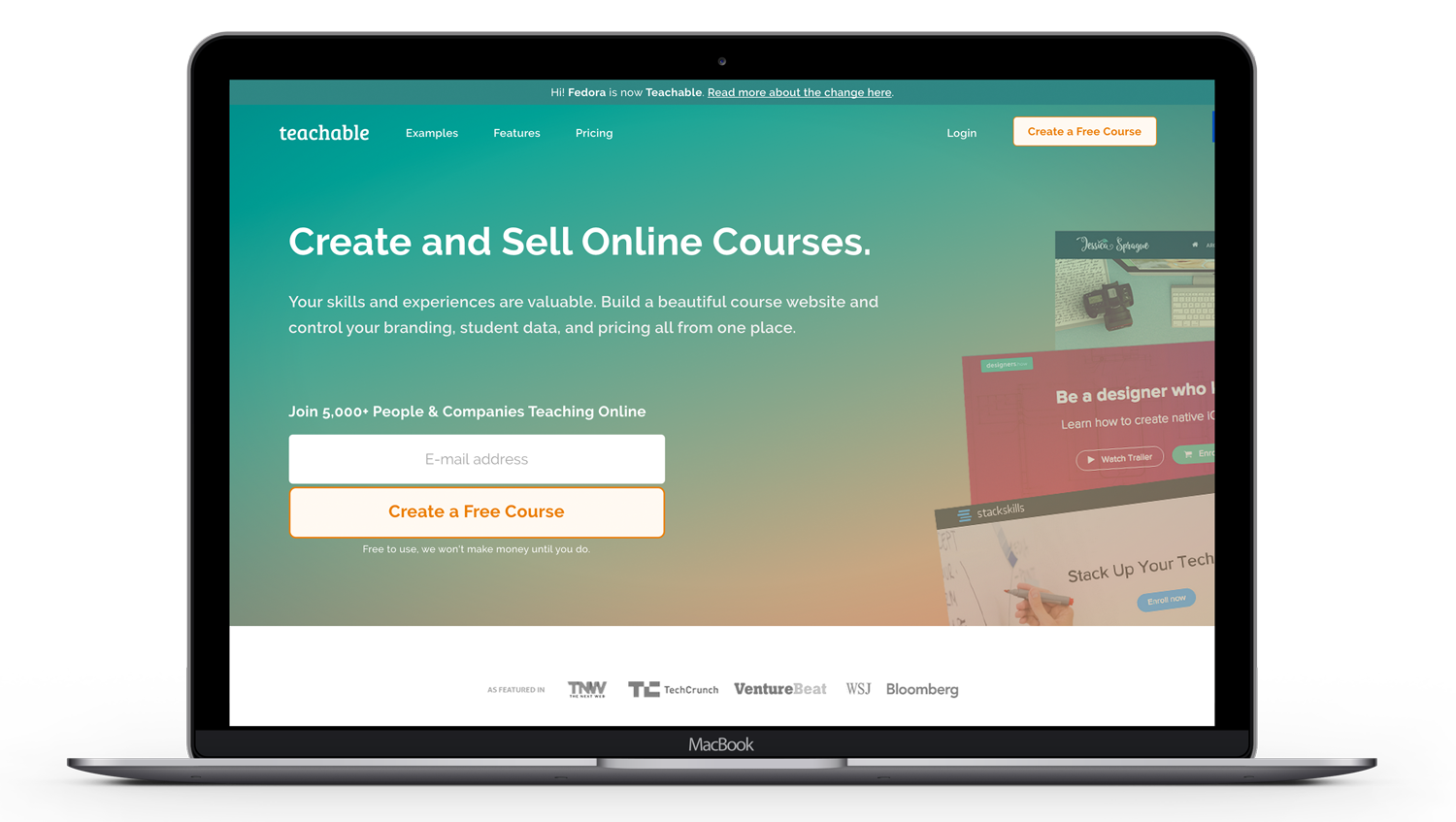
- 1) Our teachers are our customers.
- Unlike online education marketplaces catering to both students and teachers, we are laser focused on empowering our teachers to make a living teaching online.
- 2) We are expanding the scope of people that identify as teachers.
- As anyone with a younger sibling can attest, teaching is the amongst the most primal and natural things in the world. We teach before we talk, we teach our friends, family and co-workers all the time, yet we are afraid to identify as teachers.
- Whether you teach painting, programming, calligraphy or marketing, no matter if your medium is blog posts, Snapchat, Youtube videos or interpretative dance — if people learn from you, you are a teacher.
- 3) We believe the most successful teachers of the future will be entrepreneurs.
- We believe the most motivated people in the world are entrepreneurs. The most successful teachers of the future will be entrepreneurs — and those entrepreneurs are who we are proud to call our customers.
- We believe everyone can teach, and everything is teachable.
- > We are Teachable.
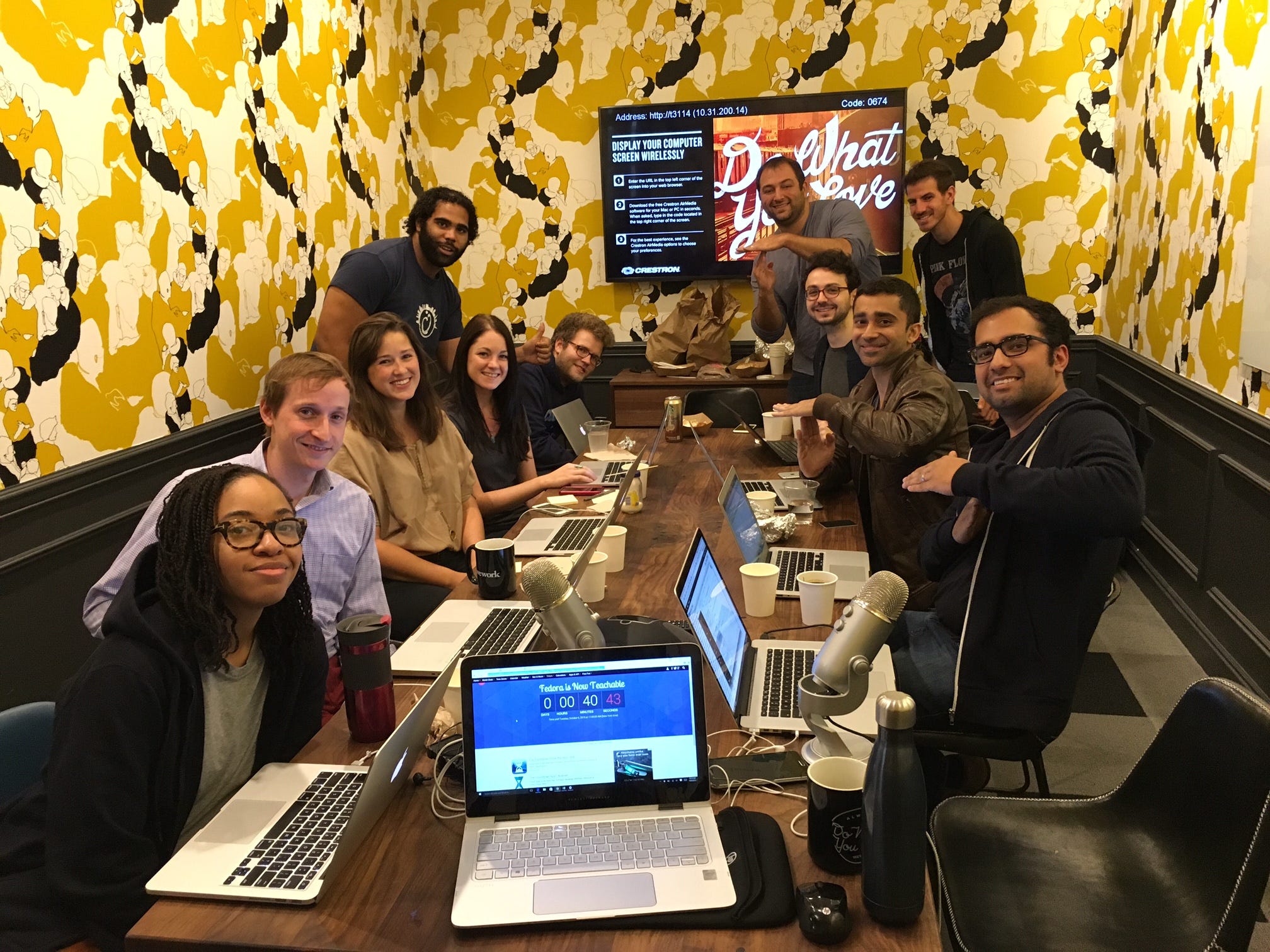
- Launch day ~5 min ago.
- Ankur Nagpal on behalf of Allison Haag, Andrew Guttormsen, Ashley Hockney, Cameron Mattis, Chris Roth, Conrad Wadowski, Dustin Eichler, Jack Phelps, Jackson Riso, Justin Glazer, Michael Poage, Noah Pryor, Ryan Bonhardt, Sid Yadav, Tovah Payne
- https://medium.com/teachable/scaling-teachable-our-journey-to-500k-in-mrr-d4adce0cb648
- Transparency is one of the four core internal values at Teachable. Outside of compensation information, we believe in making every single aspect of our business transparent internally.
- What does that mean?
- Everyone internally has access to our financials. Investor updates. Revenue dashboards. Board meeting agendas. Meeting notes from other teams. My personal Snapchat. Ok, maybe not the last one.
- But today, we’re extending our internal transparency to apply externally. And in this post, I’m going to share with you some of our most sensitive metrics: our monthly recurring revenue, the dollar value of course sales on our platform and more.
- This is terrifying.
- For a multitude of reasons, publishing this post is scary af. Every single one of our competitors will read this (oh hai Jeff!). Every company considering entering this space will read this.
- But at the end of the day, we believe the benefits far outweigh the downsides.
- The benefit that reading this post will inspire more people that value transparency to join our team at Teachable.
- The benefit that an inner look inside our business will build more trust and empathy with our customers that we aspire to treat like family.
- The benefit that transparency dramatically reduces the cost of communication.
- Finally, we believe transparency builds a better business. Transparency attracts and retains better team members and ultimately, the company with the strongest team wins.
- Now, let’s dive into the good stuff.
- Our Journey to $500k+ in Monthly Recurring Revenue (MRR)
- Teachable as a business has three primary revenue channels — one of which far outweighs the other two.
- Our primary revenue channel is our Monthly Recurring Revenue (MRR) — this is the fee that most of our teachers pay us monthly for access to the Teachable service and comprises almost 80% of our total revenue.
- Our monthly recurring revenue right now is $555,500:
- While that graph looks like a relatively smooth stairway to heaven, it masks some of the biggest challenges we have faced and will continue to face as look to grow this number almost 20x in the coming years to $10 million a month:
- We need a different growth ‘playbook’ at every stage.
- > If we wanted to grow 10% monthly two years ago, I could single handedly do that by cold emailing a few potential customers and selling to them one at a time. If we wanted to grow 10% monthly a year ago, we could host a weekly webinar to a hundred people and get 25 to buy Teachable every week. Now if we need to grow 10% monthly, we need all of the above, along with paid acquisition to deliver results, our content program to bring in more leads than before and affiliates to drive meaningful traffic. A year from now? Let’s find out ;)
- 2. Growth is linear, churn is a percentage.
- > Churn a.k.a. the percentage of customers that cancel their subscription in any given month is measured as a percentage of the total. So if we are churning 5% a month at $100,000 in MRR, that’s $5,000 a month. At $500,000 in MRR that is $25,000 a month. On the other hand, added revenue grows linearly since it’s really, really hard to exponentially add new monthly recurring revenue for an extended period of time. As you can visualize by playing around with a MRR Forecast tool that unless we continue to decrease churn with time, we’ll run into flattening growth.
- 3. We are only as successful as our teachers.
- > Whenever we measure our customers by a specific “cohort” based on when they signed up for Teachable and track them over a period of time, we find that the revenue they contribute decreases with time due to churn. For example, the March 2016 cohort that was worth $10,000 in the first month might only be worth $5,000 a year later. To offset this loss, we need to generate expansion revenue from the customers that do stick around — and ideally enough expansion revenue to cancel out churn entirely. Interestingly, our biggest source of expansion revenue is transaction and credit card fees from our customers selling courses, which further reiterates that our future success as a business is dependent on our teacher’s success.
- The single biggest inflection point for our growth trajectory was the decision to switch focus from transaction fees to recurring revenue. When we slashed transaction fees on our Pro plan to 0% (see if you can find out when by looking at the graph!), we overcame one of the biggest objections people had about joining Teachable while also increasing our average revenue per customer.
- And while churn is something we continue to fight on a monthly basis, it sure is nice to start every month at ~95% of last month instead of $0 :)
- Can Our Customers Sell a Billion Dollars of Courses?
- Our mission is to build the single best payment and e-commerce system for information. The easiest way to measure that impact is the amount of money our customers are making on the platform.
- In some regards, this number is more important than our MRR because it speaks to the impact our platform has on our customers’ lives.
- In 2014, our customers made under $1 million. In 2015, it jumped to $6 million and in 2016, it grew 5x to almost $30 million generated on our platform:
- In 2017, we are hoping to do over $120 million through the platform — with a bold target of over $1 billion in sales on Teachable in 2019.
- Where is this growth coming from?
- 1) A massive increase in volume. We now have 80,000 published courses on Teachable (top) and over 7,000,000 students that have signed up to take a course (bottom).
- 2) An increase in every single instructor’s success rate. Growing volume isn’t enough, we need to continue increasing the average amount of sales for every single instructor — and in this regard, we’re still only scratching the surface of what is possible.
- Our goal has always been that by using Teachable to sell information — you will end up making *more* money than any other solution — and enough more to offset the cost of a monthly plan.
- So far, we have been doing that by:
- > a. Building features that directly increase monetization like 1-click upsells, bundled courses, monthly and annual memberships, an advanced couponing system, different pricing tiers for a specific product, an inbuilt affiliate program, the ability to charge in 100+ currencies and so forth.
- >
- > b. Constantly testing and iterating on our checkout flow based on all the data we are collecting — for instance, we recently made the decision to move to a single-page checkout flow that has students enter their payment information first and only create an account after their purchase.
- >
- > c. Harnessing the power of our network. By intelligently remembering payment and authentication information, we can make future purchases on the network much, much faster. In an ideal world, if someone has bought a course before on Teachable, they should be able to buy your course with a single click.
- But as education and technology continue to evolve at such a rapid pace, we are only scratching the surface of what is eventually possible. And we still have not solved the biggest problem in our space: what can we do to help someone with amazing expertise without any marketing experience launch a successful business?
- New technological advancements — whether it’s the known (virtual reality, cryptocurrency, artificial intelligence, machine learning) or the unknown — will have a dramatic effect on how information is bought and consumed and Teachable will be at the forefront.
- Mo’ People, Mo’ Problems (not really though)
- If you had told me three years ago, we would have over 60 people working at Teachable, I would have likely asked you for some of what you’d been smoking.
- But as the years have progressed, our headcount has continued to approximately double every year. The business has grown at a faster rate — approximately 5x in 2015, 4x in 2016 and we are on track for between 2.5 and 3x in 2017:
- At different times, different departments have led the charge on hiring. We started out as a group of engineers and product people. Our second big phase of growth was building out a growth and marketing team to sell the product we had been building. Lately, a lot of our growth has been operational to support our business both internally — and especially externally in providing the best Customer Care humanly possible.
- Somewhat related, the number of grey hairs on my head has also grown linearly with headcount and is currently also on track to 3x in 2017.
- The best part about this sustained growth is the novelty of experience — like a video game, every few months our jobs “level up” because of how much the company has evolved in that time period.
- Consequently, the rate of learning in this environment is completely unparalleled which leads to an interesting phenomenon where a year working at Teachable is approximately the same as ~3–4 years of experience working in another environment.
- We strive to have that reflect in the career trajectory of anyone that joins our team where a year of time working at Teachable can accelerate your professional career by 3–4 years.
- And to be able to do all of that working on a product that makes a positive difference in the world?
- That’s pretty special.
- These graphs sure are sexy….
- But this is just the first chapter of the Teachable story. And we want you to help us write the rest of the book.
- Historically, if you wanted to be an entrepreneur, you sold stuff. Physical goods that you grew or manufactured or imported or bought or built.
- But today, we live in a brand new world.
- The easiest way to now start a business is by selling your expertise. By selling a product of your mind — by selling information, knowledge, services.
- And this information revolution will create more businesses and entrepreneurs than ever before.
- Teachable will be the platform to enable them. Will you join our journey?
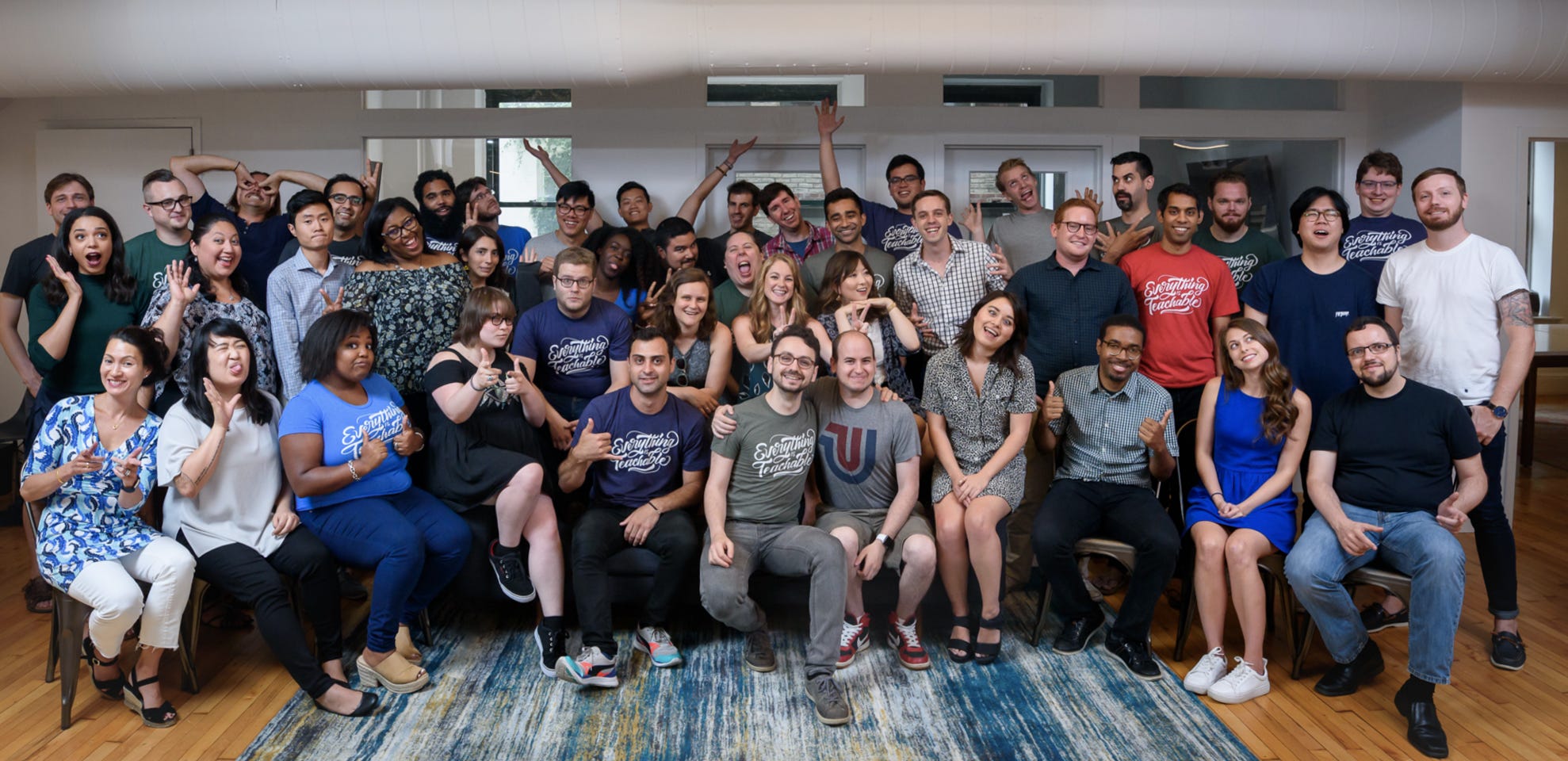
- Feedback
- Content {{word-count}}
- I've recently become fascinated by Teachable. I love their approach to education - empowering teachers to share their knowledge by helping them build businesses and reach their students directly. Their recent success is inspiring:
- https://twitter.com/ankurnagpal/status/1345013603661967361?s=19
- Teachers exhibit multiple characteristics commonly found in most types of online creators. They are traditionally undervalued, their end products have close to zero marginal cost, and they struggle to build a user base. Learning about how Teachable tackled this problem provides insight into building similar markets for other types of online creators.
- Teachable's Early Days
- Ankur Nagpal was a course creator on Udemy teaching a mobile marketing course. Frustrated by the lack of interaction with students, he decided to start building his own product called Fedora.
- His co-instructor Conrad Wadowski became his first paying customer. Through consistent outreach, he was able to have tens of users active on the platform by Summer 2014.
- There were a few people working with him on the project when it started to show some problems scaling. They rebuilt the system from scratch to create a product that could belong to the whole team. That's when Fedora was rebranded to the Teachable we know today.
- They launched the platform on Product Hunt in 2014. While only mildly successful initially, teachers started to launch their courses on Product Hunt, which all led back to Teachable. They started to experience the network effects of other creators sharing their work from Teachable's platform. By Fall 2015, they had 5,000+ teachers on the platform with 12K+ courses launched. By July 2016, the number of courses grew to 80K+.
- Ankur attributes this growth to their commitment to teacher's success. One example he cites was the "decision to switch focus from transaction fees to recurring revenue" (Source) after several teachers had complained about the fee structure. By constantly focusing on their creators and resolving their biggest pain points, they saw their business grow exponentially each year.
- Teachable was recently acquired by Hotmart, a Brazilian based company with a focus on helping creators to grow their businesses online. Teachable is looking to leverage their global reach to start empowering teachers internationally. They now have 25K+ teachers on the platform reaching 20+ million students.
- Teachable's Approach Today
- The team operates today under three convictions.
- Their customers are teachers. By prioritizing a specific user group instead of catering to both sides of the education market, they are able to iterate faster on how to improve the overall market.
- They are expanding the definition of being a teacher. They operate under the assumption that we all have knowledge to share and can share it. We don't need a degree or teaching credentials, simply the motivation to share knowledge.
- The most successful teachers are entrepreneurs. By treating their users as business owners, they help them build a sustainable practice that allows them to spend more time teaching. The teachers' success then funnels up to Teachable's success.
- This approach will continue to drive success for a company who's aligned with the success of its users.
- Applying Teachable's Approach
- What can we learn from Ankur's side project turned education platform?
- The first is to start small. The product was created simply to help Ankur turn what he was teaching into a sustainable business. By solving his own business problems, they gained greater insight into what could scale to more users. Growth exploded from there and continues to be exponential today.
- The second is to focus on one side of the market. Most markets consist of at least two user groups. When platforms split their resources trying to appeal to both sides of the market, often they end up with a subpar product for either of them. By focusing on educators, Teachable was able to build a product that one side of the education market loved. As a consequence, they saw user growth from both sides.
- The last is to build a product that increases access. By expanding who Teachable defines as a teacher, they are growing the education market, which in turn grows the number of potential customers on their platform. They built features that made it easier for people to educate and make money off of what they taught. The latter allows more teachers to teach for longer, making it their full time profession as opposed to just a side gig.
- These takeaways could apply to any type of creator's market. Open source software is one of these markets that with a Teachable type product will empower engineers to work in open source full time instead of as a side project to their office jobs.
- Resources
- To read more about Teachable's story, I recommend checking out these articles which I used as the basis for this one:
- _A Brief History of Teachable and Why We Think it’s Amazing_ - By Reachable, a client acquisition agency built on top of Teachable
- _How We Acquired 26,447 Users and $207,152 in Sales on Product Hunt_- By Ankur Nagpal
- _Fedora is now Teachable_ - By Ankur Nagpal
- _Scaling Teachable: Our Journey to $500k+ in MRR_ - By Ankur Nagpal